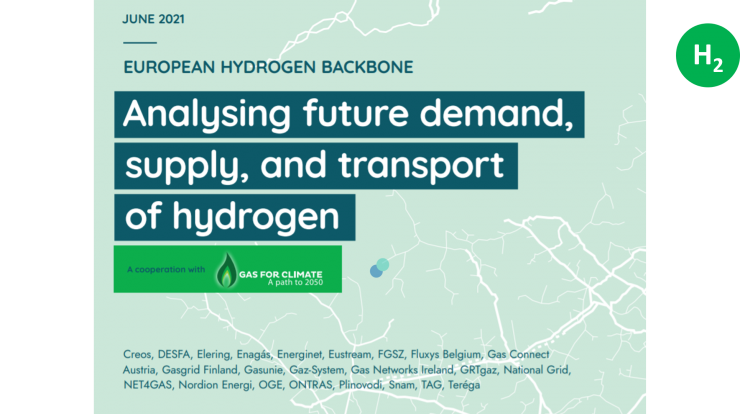2021 European Hydrogen Backbone – Analysing future demand, supply, and transport of hydrogen
Hydrogen is crucial to Europe’s transformation into a climate-neutral continent by mid-century. This study concludes that the European Union (EU) and UK could see a hydrogen demand of 2,300 TWh (2,150-2,750 TWh) by 2050. This corresponds to 20-25% of EU and UK final energy consumption by 2050. Achieving this future role of hydrogen depends on many factors including market frameworks, legislation, technology readiness and consumer choice.
Green and blue hydrogen are crucial for our industrial decarbonisation pathway. It is particularly relevant for chemicals (ammonia and high-value chemicals), iron and steel, and fuel production where hydrogen is primarily used as feedstock. Green and blue hydrogen replaces the current use of grey hydrogen in ammonia and fuel production and is a main input for the production of low-carbon fuels used in aviation or as feedstock for the production of high-value chemicals. Hydrogen-based steel making is considered the main decarbonisation option for primary steel making. About 1,200 TWh of annual hydrogen demand in industry can be expected, including just over 200 TWh for medium and high temperature industrial process heat.
Around 650 TWh of annual hydrogen demand can be expected to be required in dispatchable electricity production. The value of hydrogen over most other flexible power options is that it can be supplied and stored in large quantities at relatively cheaper investment costs, making it appealing for longer duration storage.
🔥 What about we co-host a webinar? Let's educate, captivate, and convert the hydrogen economy!
Hydrogen Central is the global go-to online magazine for the hydrogen economy, we can help you host impactful webinars that become a global reference on your topic and are an evergreen source of leads. Click here to request more details
In transport, next to electrification and biofuels, there is a clear role for about 300 TWh per year of hydrogen as a fuel. Additional hydrogen will be needed to produce hydrogen- derived synthetic fuels in aviation.¹
Heating in buildings will be decarbonised using a range of technologies with significant regional variations. The hydrogen demand depends on renovation rates, the relative shares of biomethane and hydrogen, and the mix of heating technologies. This study assumes Europe-wide accelerated renovation rates and hybrid heating systems in existing homes with a gas connection and in 30% of district heating. Such hybrid systems use electricity (in a heat pump) and renewable or low-carbon gas. This approach reduces energy system costs, enabling lower cost to consumers and faster emission reduction. As the hybrid heating systems mainly use gas as peak energy supply, gas demand is lower than in gas-only solutions like hydrogen boilers and fuel cells considered in other studies. Under this study’s assumptions, annual renewable and low-carbon gas demand in buildings will be around 600 TWh in 2050. All of this could be hydrogen, yet assuming a scale-up of biomethane as in previous Gas for Climate studies, annual hydrogen demand would be around 150 TWh.
2021 European Hydrogen Backbone – Analysing future demand, supply, and transport of hydrogen
2021 EHB – Analysing future demand, supply, and transport of hydrogen
Domestic European green and blue hydrogen supply potential is vast and exceeds what would be needed to meet projected European hydrogen demand in all sectors.
Domestic green hydrogen supply potential in the EU and UK from dedicated renewables is estimated to be 450 TWh in 2030, 2,100 TWh in 2040, and 4,000 TWh in 2050. This potential already takes into account the growing need for renewable electricity for direct consumption, land availability, environmental considerations and installation rates. Realising this potential will likely require a rapid, vast expansion of wind and solar capacity, beyond what is needed for direct electricity demand and corresponding to cumulative installed capacities of 1,900 GW in 2030, 3,200 GW in 2040, and 4,500 GW in 2050. The 2030 installed capacity figure represents a more than doubling of current cumulative National Energy and Climate Plan targets.
From 2040, green hydrogen supply potential in Europe can be sufficient to meet projected European hydrogen demand in all sectors at lower cost levels compared to grey hydrogen and other fossil alternatives plus the CO₂ price. By 2050, almost all of the potential 4,000 TWh of green hydrogen can be produced for less than 2.0 €/kg, of which up to 2,500 TWh can be produced below 1.5 €/kg and around 600 TWh produced at 1.0 €/kg or less. Supplying the entire projected 2,150-2,750 TWh hydrogen demand in 2050 would require around 2,900-3,800 TWh of dedicated renewable electricity.
However, producing such quantities of green hydrogen within the EU and UK is subject to public acceptance of an accelerated expansion of renewable installed capacity even beyond currently planned expansion.
In addition to green hydrogen, Europe also has a large potential to produce blue hydrogen. Supply is virtually unlimited as natural gas supply and CO₂¬ storage potential exceed the total foreseen hydrogen demand. Blue hydrogen production costs are expected to be 1.4-2.0 €/kg at moderate natural gas and CO₂-prices² , but could rise up to 1.6-2.3 €/kg during the 2030s and 2040s when CO₂-prices further increase. Natural gas producing countries could benefit from lower natural gas costs to produce blue hydrogen at 1 €/kg. Blue hydrogen can quickly drive emission reductions and accelerate the pace of the transition, especially in the market’s rampup phase (2030), when green hydrogen supply potential from dedicated renewables alone will be insufficient to meet local and regional demand in absence of a fully interconnected European hydrogen backbone. Although EU and UK greenfield and brownfield blue hydrogen supply potential is almost unlimited, projects announced to date add up to 230 TWh by 2030 and 380 TWh by 2035 and onwards – with 70% of announced project volumes stemming from the UK and the Netherlands.
Beyond 2030, deployment of new blue hydrogen projects will face increasing competition from green hydrogen (domestic and import), as this becomes more widely available at lower costs. However, there will still be a role for (by then) existing blue hydrogen projects—which have a lifespan of 25 years—to continue producing as the marginal supply option and to contribute to system integration and balancing of variable green hydrogen through firm, baseload hydrogen production.
READ the latest news shaping the hydrogen market at Hydrogen Central
Access the full report here








